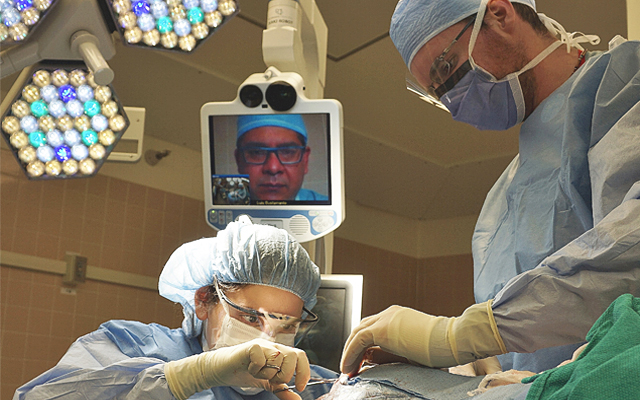Feature Story

Remote presence technology: The Saskatchewan experience
September 29, 2016
As part of the Remote Presence Medicine Program at the University of Saskatchewan, we have been using a number of remote presence mobile devices to provide medical expertise to underserviced communities in Saskatchewan.
We have worked with the communities, their leadership and local healthcare providers to identify areas of urgent, unmet need, such as access to pediatric acute critical care. We have also used remote devices for mentoring of senior surgical residents and for post-operative follow up visits in the patient’s home.
Remote presence robotic technologies provide the sense that the user is “present”, enabling physicians to provide real-time clinical services remotely.
The robotic device can be controlled for direct visualization, examination, and diagnosis of the patient, as well as communication with local healthcare professionals and family members.
These devices have multiple electronic ports for peripheral diagnostic devices such as stethoscopes, dermatoscopes, otoscopes and ultrasonography that facilitate the examination of the patient in real-time.
We have employed a number of remote presence platforms (from In Touch Health Inc., of Santa Barbara, Calif.) such as the RP-Vita remote presence robot (Figure 1), the portable RP-Xpress, for home visits (Figure 2) and RP-Vantage for surgical mentoring (cover photo, page 1).
These systems are designated by the US Food and Drug Administration (FDA) as class II medical devices and meet the prerequisites for application in acute patient care.
We are also trialing a novel telerobotic ultrasound, the Melody system (Société AdEchoTech, of Naveil, France) consisting of a robotic arm that is capable of being controlled by a sonographer to scan a patient located in a remote location in real-time (Figure 4).
The experience so far with this system indicates that telerobotic ultrasonography has the potential to answer a large unmet need of access to sonography in rural and remote communities.
The Saskatchewan experience: Over the past two years we have deployed 14 remote presence devices to a number of healthcare facilities, ranging from tertiary hospitals in Saskatoon and Regina to small nursing stations in remote First Nation’s communities.
We have focused mainly on testing the feasibility of using remote presence robotic technology to answer urgent unmet needs in underserviced communities and vulnerable populations, such as young children, pregnant women and the elderly.
A recently completed pilot study in providing pediatric specialized critical care access to acutely ill children in the Northern First Nation’s community of Pelican Narrows demonstrated that 63 percent of the acutely ill children who presented to the nursing station were able to be effectively managed locally by a pediatric intensivist located in Saskatoon with the help of the remote presence technology.
The triaging decision and interventions using this technology were sustained as none of the children treated needed to be transported up to the 14-day reassessment time.
Furthermore, 43 percent of the children that required specialized transport were safely triaged to a regional centre, thereby easing the overcapacity issues that often strain the pediatric intensive care unit in tertiary care centres.
The potential cost savings in transportation alone can be substantial as a specialized pediatric inter-facility transport by air costs approximately $10,000 and the number of pediatric transports in the province of Saskatchewan is over 400 transports per year.
Our work with the telerobotic ultrasound system has shown considerable promise. We have completed a study comparing conventional direct abdominal sonography with telerobotic sonography using the Melody system.
There was no significant difference in the capacity of the systems to visualize the intra-abdominal organs as 92 percent of organs visualized on conventional examinations were also visualized on telerobotic examinations. Furthermore, there was no difference between the two modalities in measurements of the liver, spleen, and diameter of the proximal aorta.
Providing sonography access to underserviced communities remotely is potentially transformative. We envision a network of telerobotic ultrasound systems located in remote or low-volume centres to be serviced by sonographers at central telerobotic sonography facilities.
Such clinics could provide routine examinations for patients in low-volume or underserviced communities, as well as facilitate after-hours imaging for emergent cases, possibly avoiding transport to a larger centre for imaging. In small to mid-sized centres, telerobotic sonography may also allow access to subspecialized sonography which would otherwise be unavailable.
Potential barriers and the future: Potential barriers for the implementation of remote presence robotic technology would not likely be technological. Rapid advances in telecommunications, robotics, and mobile device development are providing a solid technological platform for the future.
The barriers are likely to be related to issues pertaining to medical liability, jurisdictional legal considerations, provider remuneration, perceived costs of capital equipment, data and patient confidentiality, competing health priorities, and lack of regional and national strategies and standards for implementation of telemedicine applications.
Issues related to the disparity in access to telecommunication infrastructure may also be a factor in remote communities or developing countries.
Public expectations and pressure for cost-effective and decentralized healthcare provision may play a significant role in removing cultural barriers and streamlining of regulatory and remuneration issues.
The rising costs of transportation and the unsustainable strain on tertiary care centres of a system that encourages the concentration of services in a few large hospitals may open the way for the implementation of a cost-effective remote presence healthcare strategy.
It is clear that the healthcare industry is lagging behind the banking and airline industries in the implementation of decentralized consumer-centre solutions that remove barriers of time and distance.
Remote presence robotic technology and other telehealth solutions are rapidly expanding. The provision of point-of-care diagnosis and treatment will transform the current paradigm of centralized healthcare delivery.
Our experience in Saskatchewan leads us to believe that this technology can also help to narrow the gap of inequality in healthcare access to the most vulnerable and underservice populations in the Province.
Dr. Ivar Mendez is the Fred H. Wigmore Professor and Chairman of Surgery at the University of Saskatchewan and the Unified Head of Surgery for the Province of Saskatchewan.
